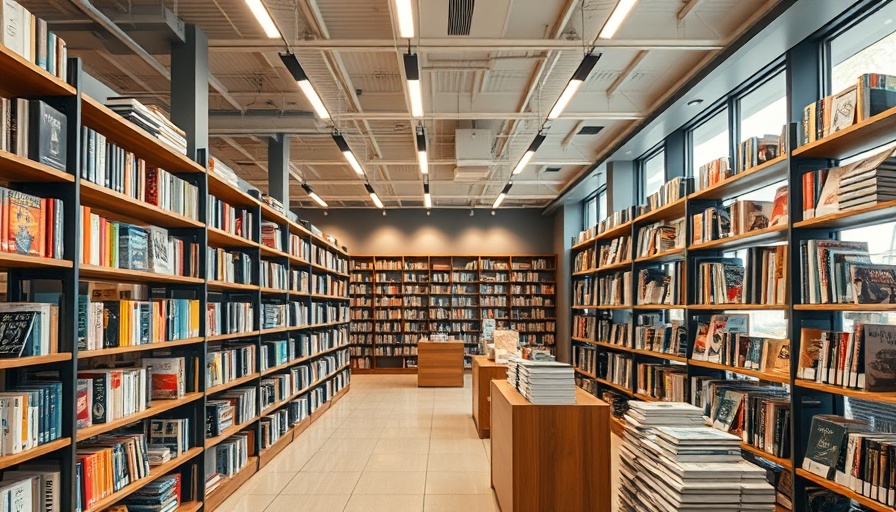
Discovering Ceramic Pages: A Bookshop Inspired by Teapots
The exquisite Ceramic Pages bookshop, designed by Wutopia Lab in Yixing, China, offers visitors more than just books; it unfolds a narrative rich with cultural heritage and architectural ingenuity. With its smooth, curving walls and spout-like skylight, this bookshop beautifully mimics the inside of a teapot—a symbol deeply intertwined with Chinese history and culture.
The Architectural Journey Built on History
Located within the redevelopment of a former clayware factory, Ceramic Pages represents a convergence of art and architecture under a broader cultural framework aimed at revitalizing the region. Not far from this bookshop lies the impressive UCCA Clay Museum, designed by renowed architect Kengo Kuma, which together enhances the artistic aura of Yixing's Creative and Cultural Ceramic Avenue. The architectural design serves not only as a functional space but also as a storytelling canvas, narrating the process of pottery making—a craft historically significant to the local community.
From Clay to Craft: The Three Floors of Transformation
Ceramic Pages is organized across three uniquely themed levels, each symbolizing a stage in the pottery-making process, echoing the philosophy that parallels craft and life. The ground floor, colored in earthy tones reminiscent of raw clay, sets the foundation for the experience, showcasing the initial stages of crafting. Custom bookshelves designed to mimic the progression from raw to refined materials echo this metamorphosis, inviting visitors to explore their own journey of growth.
The first floor transitions into hues of fire, embodying the intense kiln firing stage of pottery creation. Here, a vibrant café encourages visitors to immerse themselves in a communal atmosphere while reflecting on perseverance and passion—traits synonymous with both pottery and personal endeavors. On this floor, the space opens up to an external terrace, allowing guests a range of views that further connect them to the surrounding cultural landmarks.
Finally, the top floor envelops visitors in a serene, water-themed gallery. This area utilizes soft lighting and design features that echo natural water ripples, providing a tranquil atmosphere for reflecting on the craft's sublimation to its final, perfected form. This journey through the building paints a poetic picture of human development, mirroring life’s stages.
Restoring Cultural Identity Through Design
The design of Ceramic Pages not only reimagines a physical space but also plays a fundamental role in restoring the cultural identity of Yixing. According to Wutopia Lab's founder, Yu Ting, the creation process involved a carefully curated selection of materials that encapsulate themes of clay, water, and fire. Each visitor's movement through the space creates a tactile relationship with these elements, fostering a deep connection to the region's pottery traditions.
Through elements like the teapot spout skylight, the bookshop stands as a beacon of cultural significance. As Ting reflects, 'the act of drinking tea encompasses profound life philosophies,' suggesting that just as teapots hold worlds within them, so too can well-designed spaces inspire and nurture the human experience.
Engaging with the Local Community
Ceramic Pages aims to serve more than just book enthusiasts and architecture aficionados; it aspires to be a hub for community engagement, offering workshops, reading sessions, and cultural events that promote an appreciation for the arts and ceramics. Such initiatives highlight the bookshop's commitment to nurturing creativity and fostering connections within the community.
Visiting Ceramic Pages
Whether you are a digital nomad seeking a cozy workspace or an architecture enthusiast exploring innovative designs, Ceramic Pages invites you to engage in a unique sensory experience. The integration of symbolism and functionality in the design fosters a space that is not only efficient for working or reading but also harmonious with Yixing's rich traditions. This bookshop is a testimony to how thoughtful architecture can weave heritage into the fabric of modern life.
In this vibrant space, find inspiration in the narratives told through design and pottery, and embrace the comfort of a space where creative minds can flourish.
 Add Row
Add Row  Add
Add 




Write A Comment